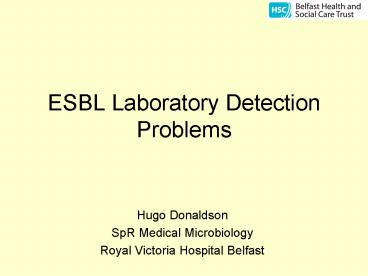ESBL Laboratory Detection Problems - PowerPoint PPT Presentation
1 / 18
Title:
ESBL Laboratory Detection Problems
Description:
ESBL Laboratory Detection Problems. Hugo Donaldson. SpR Medical Microbiology ... ESBL isolates detected by combination disc method loaded onto VITEK 2 for ... – PowerPoint PPT presentation
Number of Views:774
Avg rating:3.0/5.0
Title: ESBL Laboratory Detection Problems
1
ESBL Laboratory Detection Problems
- Hugo Donaldson
- SpR Medical Microbiology
- Royal Victoria Hospital Belfast
2
HPA National Standard Method
- Recommends
- Screening followed by confirmation
- Screening with either cefpodoxime or cefotaxime
and ceftazidime - Automated methods
3
Confirmatory Tests 1
- Double disc tests (not recommended)
4
Confirmatory Tests 2
- Combination disc methods
5
Confirmatory Tests 3
- Etest ESBL strips
6
Introduction
- VITEK2 AST N-054 card introduced in 2007.
Replaced AST N-037 card. - ESBL isolates detected by combination disc
method loaded onto VITEK2 for identification and
further sensitivities using GN id card and AST
N-054 card. - Discrepant results noted. Evaluation of each
method carried out.
7
Method 1
- ESBL producing E. coli isolates (n137) recovered
from clinical specimens from patients in
community care homes were evaluated. - MC OLeary, AC Loughrey, PJ Rooney et al. An
investigation into the Importance of Nursing
Homes in the Epidemiology of ESBL producing E.
coli. - These were phenotypically characterised by the UK
Health Protection Agency (HPA) Antibiotic
Resistance Monitoring and Reference Laboratory as
CTX-M producing E. coli.
8
Method 2
- PCR for a characteristic IS26-blaCTX-M-15 link
showed seventy-three belonged to strain A, which
typically produces a low level of CTX-M-15
enzyme 64 were non-strain A and their CTX-M
enzymes remain to be fully identified. - Woodford N, Ward ME, Kaufmann ME, et al.
Community and hospital spread of Escherichia coli
producing CTX-M extended-spectrum ß-Lactamases in
the UK. J Antimicrob Chemother 2004 54 735-743 - Karisik E, Ellington MJ, Pike R et al. Molecular
characterization of plasmids encoding CTX-M-15 ß
-lactamases from Escherichia coli strains in the
United Kingdom. J Antimicrob Chemother 2006 58
665-668
9
Method 3
- Each isolate was tested using
- the AST N-054 card for the VITEK2
- MASTDISCS? ID ESBL detection combination disc
diffusion (DD) test
10
Method 4
- All VITEK2 advanced expert system (AES)
beta-lactam phenotypic summary interpretations
that included ESBL were categorised as
successful ESBL detection - MAST DD result was categorised as successful for
ESBL detection if one or more cephalosporin zone
size was enhanced by ?5mm in the presence of
clavulanic acid
11
Results
Table 1.
a 95 confidence interval 59.7-75.1 b 95
confidence interval 94.5-99.9 c plt0.0001
12
Results
ß lactam sensitivity data
13
HPA Reporting Guidance
- Organisms inferred to have ESBLs should be
reported resistant to ALL penicillins (except
temocillin), cephalosporins (except cefoxitin),
and to aztreonam, irrespective of routine
susceptibility results
14
Discussion 1
- The ability of the VITEK2 AES to detect ESBL
production in E. coli with the AST-N054 card
(sensitivity 67.9) was poorer than the 74-100
previously reported by other investigators, who
mostly used a heterogeneous mix of ESBL producers
and other AST cards with different combinations
of cephalosporins, or AST cards with dedicated
ESBL confirmatory tests.
15
Discussion 2
- Concerns have been raised previously about the
ability of the VITEK2 AES to detect
ESBL-producing organisms with low MICs when the
investigators used AST cards containing neither
cefpodoxime nor a specific ESBL test. - Sanders CC, Peyret M, Moland ES et al. Ability
of the VITEK 2 Advanced Expert System To Identify
ß-Lactam Phenotypes in Isolates of
Enterobacteriaceae and Pseudomonas aeruginosa. J
Clin Microbiol 2000 38 570-574. - Sturenberg E, Sobottka I, Feucht HH et al.
Comparison of BD Phoenix and VITEK2 automated
antimicrobial susceptibility test systems for
extended-spectrum beta-lactamase detection in
Escherichia coli and Klebsiella species clinical
isolates. Diagn Microbiol Infect Dis 2003 45
29-34.
16
Discussion 3
- Why?
- Antibiotic panel on AST N-054 card changed from
AST N-037 (cefpodoxime replaced with ertapenem) - VITEK2 AES version (software version
WSVT2-R04.03 current at time of testing)
17
Discussion 4
- In those areas of the UK, where E. coli strain A
are the dominant producers of CTX-M-15
?-lactamase, it seems prudent to use an
alternative method to screen E. coli for ESBL
production this might include disc diffusion
testing or an alternative VITEK2 AST card.
18
Acknowledgements
M. McCalmont, D.M. Livermore, P.J. Rooney, G.
Ong, E. McHenry, R. Campbell, R. McMullan, AC
Loughrey.































